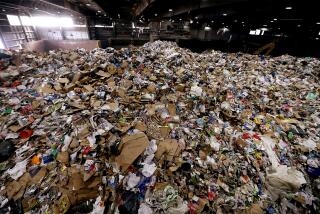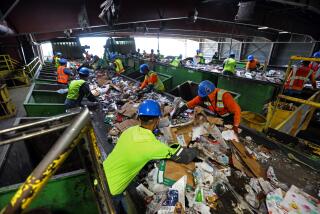Looks Are Everything : Packaging: Companies are increasingly using boxes that not only protect products but also advertise them--and generate less waste.
- Share via
ORANGE — When Cindy Baker joined the family business 13 years ago, she grudgingly admitted to a son that the world of packaging was “oh, so boring.”
“It was all brown boxes,” sighed Baker, a vice president at Scope Packaging Inc. in Orange. “Even five years ago, it was boring. But now, packing is fun and exciting.”
Cartons and containers no longer simply protect products. They also are being pressed to serve as in-store advertising devices to help merchandise stand out on increasingly crowded shelves. In warehouse-style retail stores, they also serve as an alternative to knowledgeable salespeople, who can be as rare as pro football in Orange County.
In addition, package design is being forced to take into account the glut of waste material that Americans send to the municipal dump. For instance, 34% of the total waste generated nationwide in 1993 consisted of packing material, according to the U.S. Environmental Protection Agency.
Even though a third of the 70.6 million tons of packing refuse in 1993 was recycled, packagers such as Scope are being asked to develop new designs that protect and advertise with less of an environmental impact.
“There’s a constant battle between minimizing packaging and waste and still being able to perform in terms of selling and marketing the product,” said Robert Heitzman, editor of Packaging Digest, a Chicago-based trade magazine.
Scope faced that challenge with an old package it had designed for Day Runner Inc., a Fullerton company that manufactures personal organizers. A new six-color package was designed to incorporate space for advertising yet maintain the structural strength needed to stand up to fairly rough treatment in warehouse stores.
Scope’s challenge, Baker said, was to “eliminate waste but still keep the structure necessary for stacking strength . . . and give them a carton with quality graphics.” Scope did that by changing the packaging material and using a new printing method that kept the graphics sharp--without weakening the package.
“You can’t have something thick and bulky anymore because of the waste created,” Baker said. “But you have to have a certain level of strength because no matter how intense the graphics are, no one’s going to buy a product if the package looks like it’s been stepped on.”
The design process is complicated by other factors.
Store operators demand that less-expensive items be packaged so they don’t take up as much shelf space as more-expensive items. “A $100 camera is going to get more space at Wal-Mart than a throwaway camera,” said Jeff Berkley, founder of Berkley Packaging Industries, a full-service packaging company in Irvine.
Retailers also are forcing computer software manufacturers to standardize their packaging. In the late 1980s, for example, software companies were using distinctive packaging--including tool kits for utility programs and paint cans for paint programs--to differentiate their offerings.
Established brands typically have fended off new competitors by pumping up the volume on advertising campaigns, while newcomers pushed their way onto shelves by shouting about the benefits of their new, improved products.
While massive advertising campaigns still are needed, experts agree that even the most familiar name brands can get lost on shelves of large grocery and retail stores. And as super-stores give way to mega-stores, most harried consumers simply lack the time to cruise the aisles and leisurely look for their favorite brands.
“The driving factor is clutter,” said Elliot Young, president of Perception Research Services, a Fort Lee, N.J., company that tests the appeal of hundreds of package designs annually for Campbell Soup Co. and other clients. “Now, you take a chance of getting buried in all the clutter.
Consumers can’t buy a product that gets lost in the explosion of competing colors and corporate logos, and old products start to look dated when they’re parked next to a carefully researched, state-of-the-art package.
That’s why familiar brand names--such as Betty Crocker--are getting more-frequent face lifts. Package designs used to stay on the shelves for six years, Young said, but competition has forced that cycle down to less than four years.
Packaging is still expected to do what it’s always done--keep your favorite breakfast cereal fresh and protect that new computer from dings and dents. But packaging also is viewed as cheap and effective advertising--as “something of a billboard,” said Mark Baker, a vice president at HomeBase in Irvine, a warehouse-style hardware store chain.
Two years ago, for instance, Coca-Cola Co. in Atlanta perfected the technology to manufacture its 100-year-old contour glass bottle out of plastic. “This is clearly an example of how the packaging itself can be used as a point of differentiation,” said Coca-Cola spokesman Ben Deutsch. “Our increased sales results demonstrate that.”
Gerry Tschetter, assistant general manager of Yamaha Corp. of America’s consumer products division in Buena Park, describes packaging as “your advertising, your sales brochure and your point-of-purchase display, all in one.”
One measure of the power of packaging is evident in supermarkets, researcher Young said, where spur-of-the-moment purchases--driven largely by packaging--generate a third of all sales. That means a consumer in the candy aisle is likely to bypass a pleasant-but-forgettable old standard if his or her eyes are drawn to an upstart competitor clad in a hot, new color.
Packaging design is increasingly important in big warehouse-style stores, such as HomeBase, where packages must tell consumers what they need to know about the item. No one else, after all, may know.
Chances are good, Young said, that the name brand, graphics and product description on the box or container might be all the information a consumer gets before heading to the checkout counter.
HomeBase wants packages to include a prominently displayed corporate logo and a description of what’s in the package and how it’s used. Increasingly, product details must be printed in English and Spanish.
Putting all that information on a package “is a considerable task,” Tschetter said. “The most formidable challenge comes with some new kind of computer software, where you’re trying to tell someone about something that hasn’t existed before--and you have to do it in just a few words.”
Nothing helps a product stand out in the clutter more than a solid brand name. That is why stores are awash in posters and banners carrying familiar brand names and corporate logos, which also are emblazoned on products and packaging. “These companies have a huge franchise with consumers,” said HomeBase’s Baker.
Savvy marketers such as IBM (Big Blue), Campbell’s Soup (with its familiar red cans) and Kodak (ask for the film in the yellow box) long have recognized the power incorporated into their corporate color schemes, and they take care to transfer that image to the boxes and containers that hold their products. Shoppers peering into a frosty deep freeze, for example, can easily spot the red boxes that mark Stouffer brand frozen foods or Healthy Choice’s green packages.
Corporate giants go to great lengths to ensure that their true colors shine.
Canon’s “red logo has to be exactly right,” Scope’s Baker said. “Whether it’s a plain brown shipping carton or a box for one of their [high-end printers], it has to be the exact shade of red.”
Packaging also plays an important behind-the-scenes role.
Motiv Sports Inc., an Anaheim bicycle manufacturer, won coveted space in the Sam’s Club warehouse chain after developing a packaging system that eliminates expensive assembly costs. Typically, bikes are shipped to stores where they’re assembled.
Motiv’s packaging system lets the company ship bikes that are 95% assembled, said Motiv spokesman Glenn Wilk. Stores like the system because they don’t have to have employees piecing together increasingly complex bikes. And Motiv, Wilk said, “likes it more when we’re sure that bikes are put together correctly.”
(BEGIN TEXT OF INFOBOX / INFOGRAPHIC)
Consumers’ View
Value is still what customers look for most when buying products. However, convenience ranks above recyclability as something consumers found “important” in a 1995 survey. Percent saying value, convenience and recyclability are important when they buy four products:
Product:
*--*
Personal Non-prescription Household Trait Food care drugs products Value for the money 91% 88% 87% 87% Convenience in resealing 79% 83% 86% 81% Convenience in opening 71% 80% 80% 76% Recyclability 55% 53% 54% 57%
*--*
Trash Load
The total amount of container and package waste increased 9.2% from 1990 to 1993, the most recent year for which information is available. But container/package refuse as a percentage of all waste has remained about the same. About one-third of packing waste in 1993 was recycled.
Package/Container Waste
(in millions of tons)
1990: 64.8
1991: 65.3
1992: 68.1
1993: 70.6
Percent of Total Waste
1990: 32.7%
1991: 33.2%
1992: 33.6%
1993: 34.1%
Source: Packaging Digest, Environmental Protection Agency; researched by JANICE L. JONES / Los Angeles Times
More to Read
Inside the business of entertainment
The Wide Shot brings you news, analysis and insights on everything from streaming wars to production — and what it all means for the future.
You may occasionally receive promotional content from the Los Angeles Times.










